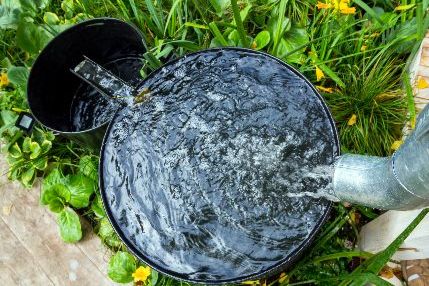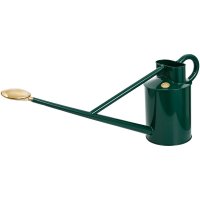
- What time of the day is best for watering vegetable and flowers plots?
- How often should I water my garden?
- How to properly water potted plants, flower pots and balcony flowers
- Water raised beds daily
- Watering the lawn on hot days
- Watering with a watering can, garden hose or irrigation system
- Harvesting rainwater for garden watering
- 5 tips to water your garden properly
Watering your garden properly is an art in itself. To avoid damaging your plants, there are a few things you need to know.
What time of the day is best for watering vegetable and flowers plots?
Whether it is a vegetable plot, a flower pot or a lawn - the best time to water is early in the morning. There are several reasons for this: during the day the plants have a high demand for water, which the gardener has to supply in the morning. Also, the sunlight is at its lowest in the morning, so that the water does not evaporate again immediately, but can soak the soil through to the roots. The ultimate goal of watering is that the water penetrates as deeply as possible into the soil.
Many working people do not have enough time to water the garden in the morning, so late evening watering is also a good alternative. Using a watering can or a garden hose at midday or in the afternoon, when the sun is at its peak, is strongly discouraged as far too much water evaporates at these times. In addition, every drop of water that falls on the plant could cause scorching.
How often should I water my garden?
»Less (often) is more« is the dictum when it comes to watering your garden. In practice, this means not watering a little every day, but more intensively once a week. The aim is for the plants to grow strong roots and develop into vigorous flowers, vegetables or perennials. The gardener can encourage this development by watering less frequently and thus allowing the plants to meet their water needs through root growth into deeper layers of the soil.
Indeed, it is not easy to get out of the habit of watering the garden every day. Even in summer, when temperatures are high, you only need to water a reasonable amount once or twice a week. Just make sure not to be pedantic about watering, but to trust your gut instinct. All you have to do is put your hand on the soil and if it feels dry, water it, regardless of when it was last watered.
How to properly water potted plants, flower pots and balcony flowers
For bedding plants, the stated aim is to encourage as deep a root system as possible. Of course, this is not necessary for potted plants and balcony flowers. Any plant that is grown in a container needs more water than one grown in a flower bed. This is because the pot basically does not store as much water. However, you should also avoid giving them too much water, as stagnant water can lead to rot. The following applies: Stick your finger in the soil and check how wet or dry the root ball is.
Water raised beds daily
Raised beds need intensive watering just like potted plants. The rules for traditional beds do not apply here because the raised bed is a self-contained microcosm with different needs than a normal bed. Raised beds have a higher yield, but they also use more water. This is because the compost layer in the bed also needs a lot of water. Therefore, on hot summer days, it may be necessary to water the raised bed in the morning and evening, depending on the location.
Watering the lawn on hot days
Last but not least: the lawn. It only takes a few really hot days for the lawn to turn brown. Grass reacts immediately to high temperatures because it does not have very deep roots; they do not penetrate more than 15 centimetres into the soil. That is why lawn watering is unavoidable in hot summers. As previously mentioned, the first 15 centimetres are important; as soon as they dry out, the gardener should water with a sprinkler. Mulch mowing also reduces evaporation and keeps the lawn fresh for longer.
How often should I water my lawn? As a rule of thumb, loose sandy soils that do not retain water well, should be watered every three to four days. Loamy and clay soils should be watered once a week. Basically, it is better to water less frequently, but all the more thoroughly.
A dry lawn not only looks untidy, but weeds find it easier to grow. As soon as the first brown patch appears, the weeds shoot up from the dead lawn. And once they've taken over, there's no getting rid of them.

Watering with a watering can, garden hose or irrigation system
There are countless watering methods. Here is an overview of the most common and most practical ways to water your garden, balcony and lawn. The classic method for watering potted plants and balcony flowers is to use a watering can. This is the best way to dispense the right amount. However, some balcony gardeners have installed an automatic drip irrigation system in their green oasis to keep the flowers moist. Automatic watering systems are a little more complicated to install, but then the gardener does not have to worry about watering all summer. This is a real time saver for the high water requirements of potted plants or even the raised bed. Sprinklers are an innovative solution for raised beds. Special Spray Nozzles are perfect for watering seedlings, saplings and young vegetable plants.
The proper watering technique for flower beds


The garden - whether it is a vegetable plot, rose garden or perennial hedge - is usually watered with a garden hose. Make sure to water as close to the ground as possible, because many plants do not like being watered from above. Tomatoes and kohlrabi are very sensitive. However, other plants also respond to wet leaves with fungal infections. In summer, avoid the so-called »Lens effect« - i.e. droplets of water act as lenses, focusing the sun's rays onto a small spot, burning the leaf.
For easy shallow watering, a Spray Lance is recommended. This is an extension of the hose used to direct the water to the root base. A very back-friendly tool for the gardener. Hose Deflectors are recommended so that the hose does not damage the plants in the flower beds or is itself damaged on a house wall.
Time-saving lawn watering with sprinklers
The lawn can be watered in the traditional way with a watering can or garden hose. However, the vast majority of garden owners use a lawn sprinkler - also called Spray Nozzle. These automatically water the lawn. Very practical for working gardeners, as the green areas at home can be watered on a timer. In addition, automatic irrigation systems distribute smaller amounts of water over a longer period of time - so the soil can absorb the water better than when watering in gushes with a hose.
When installing an automatic watering system, the gardener should make sure that the precious water resource really does end up on the lawn and not on the path or on the house wall. The shape and size of the garden are key when choosing the right lawn sprinkler. After all, every patch of lawn needs to be watered. Gardeners with mobile sprinklers place the irrigation system at different locations in the garden everyday - this ensures that the whole area is covered and not too much water is used. Fixed watering systems need to be carefully designed so as to ensure that the entire lawn is watered.

The robust Boutté Spray Baseplate can be connected in series. Here, for example, with the Boutté »Rotor« Spray Nozzle
Harvesting rainwater for garden watering
Water is becoming an increasingly valuable resource, even in our latitudes. If you want to be a bit more independent of the tap and wish to water your own garden in a water-saving way, you can use collected rainwater. Rainwater is cheaper and more ecological than drinking water. The easiest way to collect rainwater for garden irrigation is from the down pipes of the gutter. Place a large water butt underneath so that not a drop of water is lost. This is probably the cheapest way to collect this valuable resource. Naturally, a water butt offers the advantage of collecting a large volume of rainwater and a drainage tap makes it easier to fill watering cans - especially when the butt is slowly becoming empty.

Regarding water shortages: in summers with low rainfall, the collected rainwater quickly runs out and the gardener has to resort to drinking or tap water again. This is the reason why ambitious gardeners eventually take the step of building an underground tank or cistern in their garden. These are underground water storage systems that can often store several hundred litres of water. They collect the year's rainfall and use it to water the garden in the summer.
5 tips to water your garden properly
- Collect rainwater and use it to water on hot days.
- It is better to water less frequently, but more intensively.
- Water close to the ground, avoiding watering leaves and flowers.
- Water in the morning or evening - in the hot sun, water evaporates quickly and there is the risk of the »Lens effect«.
- Potted plants, balcony flowers and raised beds need more water than traditional beds.







